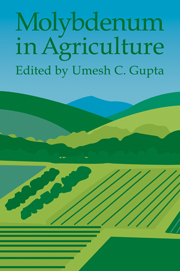Book contents
- Frontmatter
- Contents
- List of contributors
- Preface
- 1 Introduction
- 2 Chemistry and Mineralogy of Molybdenum in Soils
- 3 Distribution and Mobility of Molybdenum in the Terrestrial Environment
- 4 Biochemical Significance of Molybdenum in Crop Plants
- 5 Soil and Plant Factors Affecting Molybdenum Uptake by Plants
- 6 Analytical Techniques for Molybdenum Determination in Plants and Soils
- 7 Testing for Molybdenum Availability in Soils
- 8 Molybdenum Availability in Alkaline Soils
- 9 Deficient, Sufficient, and Toxic Concentrations of Molybdenum in Crops
- 10 Symptoms of Molybdenum Deficiency and Toxicity in Crops
- 11 Sources and Methods for Molybdenum Fertilization of Crops
- 12 Yield Responses to Molybdenum by Field and Horticultural Crops
- 13 Responses of Forage Legumes and Grasses to Molybdenum
- 14 Molybdenum and Sulfur Relationships in Plants
- 15 Molybdenum in the Tropics
- Index
12 - Yield Responses to Molybdenum by Field and Horticultural Crops
Published online by Cambridge University Press: 10 December 2009
- Frontmatter
- Contents
- List of contributors
- Preface
- 1 Introduction
- 2 Chemistry and Mineralogy of Molybdenum in Soils
- 3 Distribution and Mobility of Molybdenum in the Terrestrial Environment
- 4 Biochemical Significance of Molybdenum in Crop Plants
- 5 Soil and Plant Factors Affecting Molybdenum Uptake by Plants
- 6 Analytical Techniques for Molybdenum Determination in Plants and Soils
- 7 Testing for Molybdenum Availability in Soils
- 8 Molybdenum Availability in Alkaline Soils
- 9 Deficient, Sufficient, and Toxic Concentrations of Molybdenum in Crops
- 10 Symptoms of Molybdenum Deficiency and Toxicity in Crops
- 11 Sources and Methods for Molybdenum Fertilization of Crops
- 12 Yield Responses to Molybdenum by Field and Horticultural Crops
- 13 Responses of Forage Legumes and Grasses to Molybdenum
- 14 Molybdenum and Sulfur Relationships in Plants
- 15 Molybdenum in the Tropics
- Index
Summary
Introduction
The fact that higher plants need molybdenum (Mo) was recognized as early as 1930s, as described in many early review articles (Hewitt, 1956; Anderson, 1956; Stout and Johnson, 1956; Rubins, 1956; Evans, 1956; Davies, 1956; Purvis and Peterson, 1956; Reisenauer, 1956). A later review, by Gupta and Lipsett (1981), covered every aspect of soil fertility: Mo fertilizers and their application, the physiological roles of Mo, determinations of Mo in plants and soils, factors affecting plant uptake of Mo, and the problems of toxicity and deficiency of Mo. The importance of Mo was first noted in legumes, because clovers (Trifolium spp.) were extensively used in mixed pastures in Australia. Since that time, Mo deficiencies have been identified in many other legumes, such as soybeans, alfalfa, peas, and various beans. Molybdenum deficiencies have also been reported in nonlegume crops. The early experiments revealed that Mo not only is required for nitrogen (N) fixation by rhizobia for use by legumes but also is required for nitrate reductase utilization by legumes and nonlegumes. Field data on yield responses to applied Mo are more limited than for other essential elements; because of the low requirements for Mo, it has not been as thoroughly studied as other elements. Because Mo deficiencies are found in acid soils, other infertility factors have tended to mask Mo deficiencies, and thus we have fewer data on crop yields in response to Mo in field and horticultural crops. The plant part and age at testing are important in diagnosing Mo deficiencies.
- Type
- Chapter
- Information
- Molybdenum in Agriculture , pp. 182 - 201Publisher: Cambridge University PressPrint publication year: 1997
- 11
- Cited by

